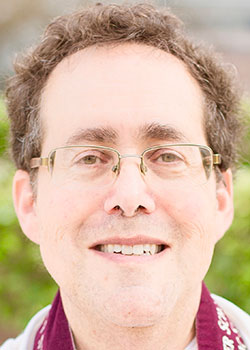Every place is not the same. Intuitively, we have a sense that there are distinctions of space that are just as fundamental to human identity as are distinctions in time. When we enter the elevated vaults of a Gothic cathedral, marvel at the staggering beauty of the Grand Canyon, or shrink under the lofty heights of a New York skyscraper, we respond distinctly to different spaces. Not all places are alike. But is the distinction between one place and another something intrinsic to the place itself, or the result of perceiving different meanings in different places? Would there be different places if there were no different viewers?
Today's Torah reading contains the first biblical example of a sacred space, and thereby provides a view of how Judaism approaches the notion of distinction in space. Moses, having fled from Egypt and his execution of a cruel taskmaster, arrives in Midian, and attaches himself to the family of a local patriarch, Jethro. One day, while caring for Jethro's flock, Moses approaches a mountain where he sees a strange phenomenon. It looks like a burning bush, although the bush appears to be impervious to the fire. His curiosity aroused, Moses approaches the flame.
Suddenly, the holy voice of God commands, "Do not come closer. Remove the sandals from you feet, for the place on which you stand is holy ground." Is the ground holy because there is something special and unique about that particular place, or is its holiness contextual, deriving from its special use?
What makes a place holy? The great Ga'on, Saadia (10th Century Babylonia), was one of the earliest to recognize that holiness is not intrinsic to any one particular site, that holiness is the result of what we do and the meaning we can focus into a particular moment or a special ritual. In commenting on the words, "holy ground," Saadia explains that this means "made holy." The sanctity of that site derives from what God and Moses do there, not from the nature of the place itself.
Similarly, Ramban (13th Century Spain) recognizes that "even though [the site] is distant from the bush, take care with it, because the descent of God's presence sanctified all of the mountain."
Hizkuni (13th Century France) notes a similar description elsewhere in the Bible. When Joshua is commanded to circumcise the Israelites, he is told that the place is sacred -- so he should remove his shoes, and when the priests ministered in the Tabernacle's holy of holies, they did so barefoot. Why? "Because in every instance in which a sign of God's presence precedes prophecy, there you find the place 'sanctified.'"
Judaism wrestles with the tension created by the unequal natures of God and humanity. We are finite and tangible. We perceive reality through our senses and we experience meaning through our emotions. God, according to Jewish teaching, is beyond body, beyond limit or understanding. How can two such different orders of being meet in relationship? How can the infinite and the universal accommodate the needs of the moral and the individual? How can God and humanity ever meet?
From the perspective of human need, sacred space is real and essential. We require, in the words of religion professor, Jonathan Smith, "a focusing lens for meaning." That is the function of sacred space. In that space, made sacred because of what we do there and what we experience there, we can explore our spiritual depths, encounter the holiness of life, and reaffirm our sacred identity as Jews.
In our synagogues and houses of study, we can encounter God. But God does not need sacred space. If God is everywhere, then all space is equally sacred, presenting equally an insight into God's presence and promise. Sacred space is religion's accommodation to human beings. Our finititude, our need to witness the special signs of sanctity (the Torah scroll, the Tallit, or the Shabbat candles), to hear the sounds that recall religious fervor (the shofar call or the chant of Kol Nidre) all contribute to our sense of meaning and connection.
God may not need our rituals, but being fully human requires establishing reliable tools to focus our attention, to help us concentrate on who we are and what we value, to link us to the universe and its creator.
Moses stood on sacred soil because in that context he was in the presence of God and he knew it. We, too, stand in a sacred place any time we are aware of the lofty potential of that moment and of all moments. Perhaps that is the ultimate mission of the Jew -- to transform every moment into a sacred moment and every place into a sacred place. Then, in a world of ritual profundity, ethical rigor and social justice, we too will remove our shoes in reverence -- the better to savor God's awesome embrace.

